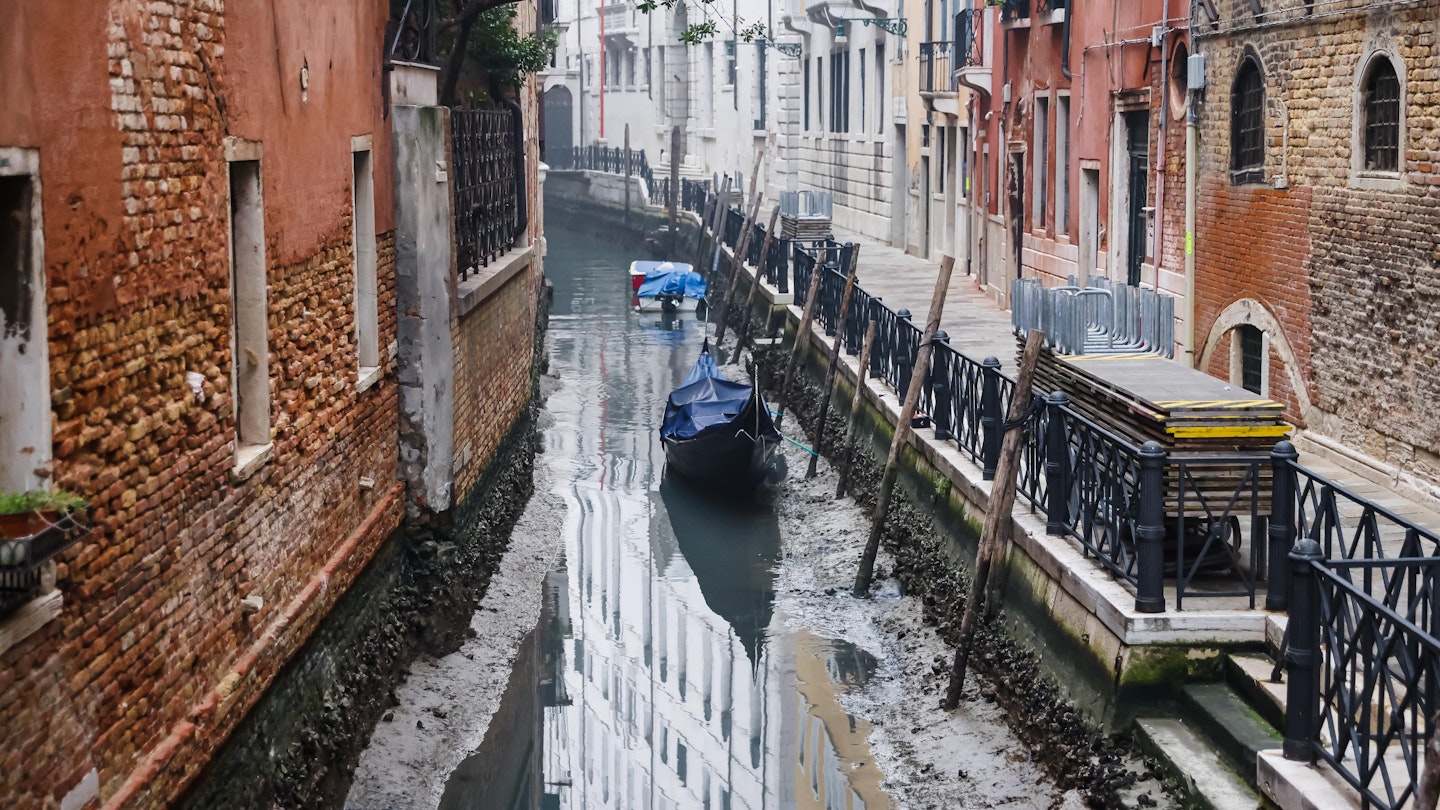Feb 28, 2023 • 4 min read

If you’ve seen photos of Venice over the past few weeks, there’s one thing you won’t have missed: the half-dry canals, containing more mud than water.
It’s the result of bassa marea, or low tide – although in Venice that means something rather different than you might expect. Also known as acqua bassa, or low water, the term is used when water levels in the lagoon city are more than 50cm (20in) lower than average. Last week, levels reached a low of -70cm (28in below average).
So what’s going on, and how will it affect your trip to Venice? Here’s everything you need to know.
What’s Drying Up the Canals?
We’ve all heard of acqua alta – Venice’s “high water” flooding. That happens when an abnormally high tide combines with low air pressure. Bassa marea is the opposite – an abnormally low tide meeting high air pressure. Italy has had almost a month of high pressure.
While many have attempted to draw a link between the dry canals and climate change, it’s not directly the case at this time, according to Dr. Warren Cairns, a senior environmental scientist.
“It’s hard to link this particular event to climate change – it’s due to low lunar tide and high pressure over Italy,” he explains.
Where climate change does come in, is that a prolonged period of high pressure is currently causing drought – with droughts being observed around Europe causing concern in numerous regions. In the case of Venice’s canals: “[the high pressure has] been over us for so long that it eventually coincided with a low lunar tide, causing the exceptionally low water,” says Cairns.
When the tides are low, the water level drops in the canals, revealing the mud and dirt that coats them. It’s not pretty, but it is natural.

How Long is This Expected to Last?
In the last few days, the situation has started improving. Over the weekend, water levels were edging towards normal, though they’re set to decrease again later in the week.
The good news is it’s unlikely to return in 2023. Bassa marea is a typical winter phenomenon, usually occurring in January and February. Normally it only lasts a few days; it’s the high-pressure area over Italy that has extended its duration this time.
Can I Still Take a Gondola Ride?
Yes, though there are a couple of things to consider for a better experience. To see more water and less mud, avoid taking a gondola for a couple of hours around low tide – the closer you are to high tide, the more water will be in the canals.
If it’s a very low tide, you’ll get a better (and more photogenic) experience on the Grand Canal, rather than the smaller side canals, where fluctuations in water levels are more pronounced. Conversely, on a regular day, those smaller canals provide a more atmospheric experience than the busy Grand Canal.
Is There Another Iconic Venice Experience Available Without Canals?
Absolutely. The list of the best things to do in Venice includes plenty of options beyond gondola rides. In addition to museums and galleries, consider taking a vaporetto (waterbus) to one of Venice’s outer islands: Murano is world-renowned for its glass, and Burano is known for its colorful houses and lace-making traditions.
How Might It Affect My Trip?
When water levels drop exceptionally low – 60cm below average – a handful of vaporetti are diverted down the Grand Canal. Transportation companies send out alerts via various apps. If smaller canals are closed to traffic, that could affect your water-taxi ride.
On a positive note, low water levels reveal details of the city that are usually hidden, such as the carved lion heads around the base of some historic buildings.

What About Flooding – When is That a Risk?
Venice is, of course, better known for its flooding than for dry canals. The flooding season typically runs from October to March. However, thanks to the installation of flood barriers, the issue has been mitigated since October 2020. The area most likely to flood remains Piazza San Marco.
This iconic waterfront square starts flooding well before the flood barriers are activated. When that occurs, simply buy a pair of disposable boots from local vendors – and remember, like bassa marea, acqua alta only lasts for a couple of hours, twice a day.





